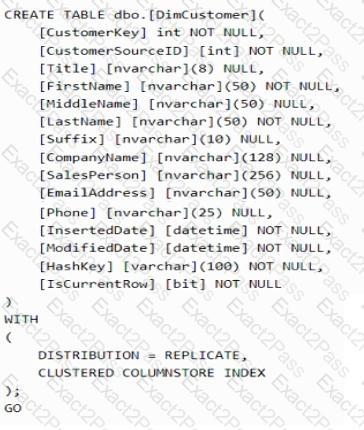Last Update 3 hours ago Total Questions : 361
The Data Engineering on Microsoft Azure content is now fully updated, with all current exam questions added 3 hours ago. Deciding to include DP-203 practice exam questions in your study plan goes far beyond basic test preparation.
You'll find that our DP-203 exam questions frequently feature detailed scenarios and practical problem-solving exercises that directly mirror industry challenges. Engaging with these DP-203 sample sets allows you to effectively manage your time and pace yourself, giving you the ability to finish any Data Engineering on Microsoft Azure practice test comfortably within the allotted time.
What should you do to improve high availability of the real-time data processing solution?
You use Azure Stream Analytics to receive Twitter data from Azure Event Hubs and to output the data to an Azure Blob storage account
You need to output the count of tweets during the last five minutes every five minutes. Each tweet must only be counted once.
Which windowing function should you use?
You have an Azure subscription that contains an Azure Synapse Analytics dedicated SQL pool named Pool1. Pool1 receives new data once every 24 hours.
You have the following function.

You have the following query.

The query is executed once every 15 minutes and the @parameter value is set to the current date.
You need to minimize the time it takes for the query to return results.
Which two actions should you perform? Each correct answer presents part of the solution.
NOTE: Each correct selection is worth one point.
You have an Azure Synapse Analytics Apache Spark pool named Pool1.
You plan to load JSON files from an Azure Data Lake Storage Gen2 container into the tables in Pool1. The structure and data types vary by file.
You need to load the files into the tables. The solution must maintain the source data types.
What should you do?
You are designing an Azure Databricks cluster that runs user-defined local processes. You need to recommend a cluster configuration that meets the following requirements:
• Minimize query latency.
• Maximize the number of users that can run queues on the cluster at the same time « Reduce overall costs without compromising other requirements
Which cluster type should you recommend?
You are building an Azure Analytics query that will receive input data from Azure IoT Hub and write the results to Azure Blob storage.
You need to calculate the difference in readings per sensor per hour.
How should you complete the query? To answer, select the appropriate options in the answer area.
NOTE: Each correct selection is worth one point.

You have an Azure Synapse Analytics dedicated SQL pool named pool1.
You plan to implement a star schema in pool1 and create a new table named DimCustomer by using the following code.

You need to ensure that DimCustomer has the necessary columns to support a Type 2 slowly changing dimension (SCD). Which two columns should you add? Each correct answer presents part of the solution. NOTE: Each correct selection is worth one point.

